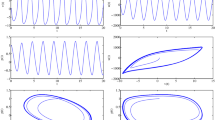Abstract
We consider ann-component biochemical system whose Jacobian matrixJ is of upper Hessenberg form, with principal subdiagonal elementsb 1,b 2, ...,b n−1 and upper right-hand corner element −f. The open-loop Jacobian matrixJ 0 is formed fromJ by settingf=0. It is shown that if the characteristic roots of −J 0 are real and non-negative then a necessary condition for instability at a critical point (steady state) is
This condition is analyzed in terms of reaction orders. For a metabolic sequence with some reversible steps, no loss of intermediate metabolites, and competitive inhibition of the first enzyme by the last metabolite, the above necessary condition becomes
whereN is the number of components (metabolites, enzyme-substrate complexes, and enzyme-inhibitor complex),β N-1 the order of the enzyme-inhibitor reaction (with respect to the inhibitor),ξ N-1 the order of reaction for the removal of the last metabolite, andX n+1 /E 0T the fraction of first enzyme blocked by inhibitor. It is shown that, under certain assumptions, a critical point is always stable in a single two-step enzymatic process (formation of enzyme-substrate complex, followed by conversion to product, then loss of product) with slow negative feedback by competitive product inhibition. A model is constructed showing that stable oscillations can occur in a feedback system with only two metabolic steps and negative feedback by competitive inhibition with no cooperativity. The instability is due to a slow feedback reaction and saturable removal of the second metabolite.
Similar content being viewed by others
Literature
Heinrich, R., S. M. Rapoport and T. A. Rapoport. 1977. Metabolic regulation and mathematical models.Prog. Biophys. Molec. Biol. 32, 1–82.
Higgins, J. 1967. The theory of oscillating reactions.Ind. Engng Chem. 59 (5), 18–62.
Hunding, A. 1974. Limit-cycles in enzyme-systems with nonlinear negative feedback.Biophys. Struct. Mechanism 1, 47–54.
Reder, C. 1988. Metabolic control theory: a structural approach.J. theor. Biol. 135, 175–201.
Savageau, M. A., E. O. Voit and D. H. Irvine. 1987. Biochemical systems theory and metabolic control theory: 1. Fundamental similarities and differences.Math. Biosci. 86, 127–145.
Searle, S. R. 1966.Matrix Algebra for the Biological Sciences. New York: Wiley.
Sorribas, A. and M. A. Savageau. 1989. Strategies for representing metabolic pathways within biochemical systems theory: reversible pathways.Math. Biosci. 94, 239–269.
Thron, C. D. 1991. The secant condition for instability in biochemical feedback control—I: The role of cooperativity and saturability.Bull. math. Biol. 53, 383–401.
Walter, C. 1969. Stability of controlled biological systems.J. Theor. Biol. 23, 23–38.
Wilkinson, J. H. 1965.The Algebraic Eigenvalue Problem. Oxford: Clarendon Press.
Author information
Authors and Affiliations
Rights and permissions
About this article
Cite this article
Thron, C.D. The secant condition for instability in biochemical feedback control—II. Models with upper hessenberg jacobian matrices. Bltn Mathcal Biology 53, 403–424 (1991). https://doi.org/10.1007/BF02460725
Received:
Issue Date:
DOI: https://doi.org/10.1007/BF02460725




